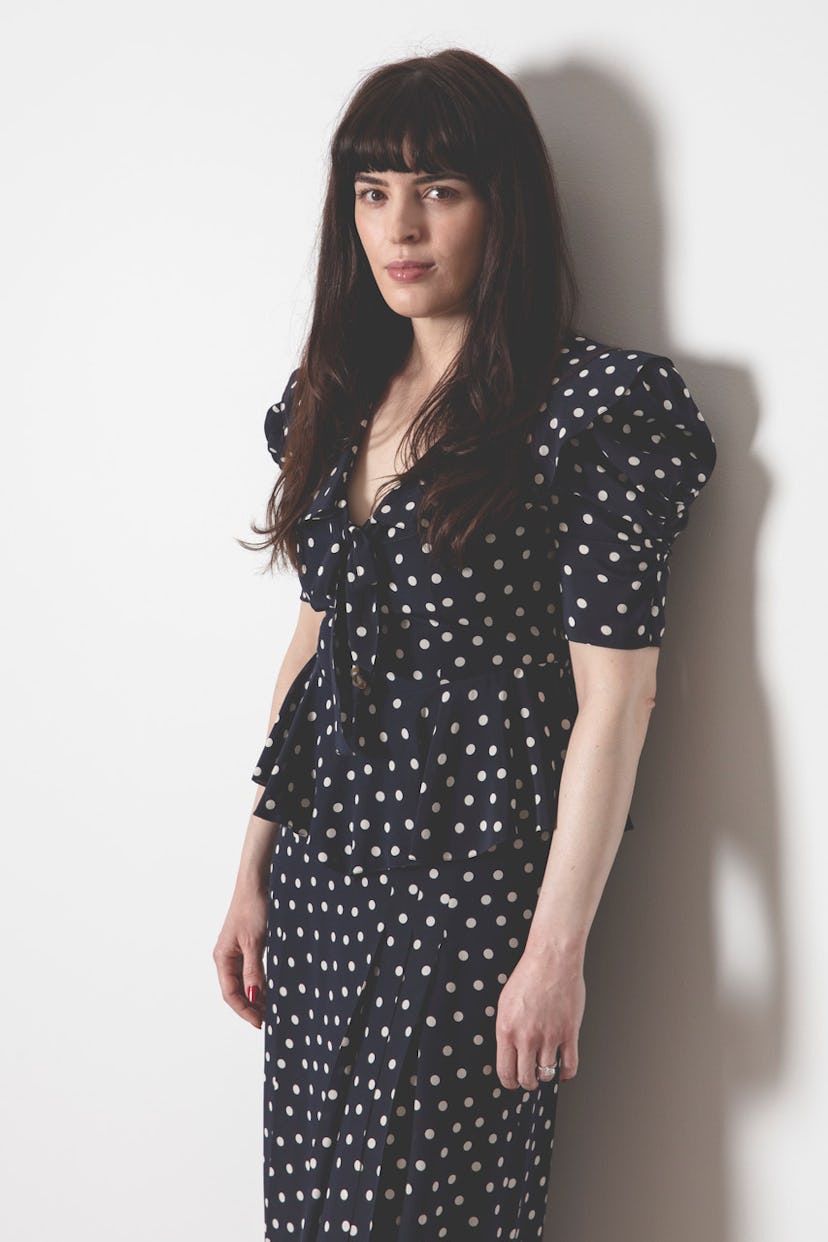Sophia Narrett’s signature wall-hung embroideries typically depict lush, sprawling panoramas of gallivanting figures and bountiful flora. Characters in these stitched-together scenes are a sensual bunch—frequently spotted en masse in mutual, orgiastic bliss. Out-in-the-open sexual romps are just a way of life in the microcosms Narrett envisions.
For Narrett, however, such rowdy exploits are not as much about carnal desire as they are outward expressions of a more profound inner spark stoked by passion and intimacy. In Carried by Wonder, Narrett’s solo debut at Perrotin in New York, her latest body of work finds narrative cohesion in that hidden emotional pull, and its power to make relationships feel eternal.
“I’m thinking about the connections between people,” Narrett explains of the series. “Not just lovers, but the universality of how, in experiencing romantic love, we are swept away from rationality and reason.” Now, nearing a decade since Narrett’s first NYC solo show, Carried by Wonder is proof that, for this artist, the topic remains a wellspring of inspiration.
Across the six works on view, “the traditions aren’t necessarily [always] readable or explicit,” she says. “It’s more about how tradition plays into rituals around love.” The effect is an homage to formal conventions that, while dictated by cultural heritage, affirm the transcendent state of falling in love—at once deeply personal and universal.
Installation views of Carried by Wonder by Sophia Narrett at Perrotin New York, 2023.
One overarching motif: each piece features at least one figure in bridal garb. Observe, for instance, the apparent bride-orgy sub-plot in “Charms” (2022). Elsewhere, the bride takes on main character energy; in “Seven Circles” (2022), she’s half floating, half twirling in the foreground of a vast expanse of tulips while a man’s form idles in the distance. Narrett notes the scene is a direct interpretation of the Jewish wedding tradition in which the bride walks around her husband seven times to symbolically “create a circle of protection around him, or make him the center of the home,” she says. Although, she adds, she also sees it as “an empowering gesture of being the one creating that protection.”
“It resonated with this tension that I’m drawn to: something being potentially empowering but also potentially restricting,” Narrett continues, “which speaks to my ambivalent relationship to traditional feminine roles, but also finding beauty in them.”
Narrett, who is currently based in Washington, D.C., grew up between New Hampshire and Maryland. She remembers as a child being “very into my dollhouse,” often crafting to-scale foodstuffs from Sculpey clay along with fabric clothes and bedding. Her professional artistic interest in romance and eroticism dates back to her undergrad days as a visual arts major at Brown, when she began thinking about these themes “as a way to transcend boredom, loneliness, and isolation.” By the time she entered RISD’s MFA program, embroidery had become her medium of choice—and likewise a means by which to further explore escapist and fantastical tendencies as extensions of genuine love.
Sophia Narrett, Carried by Wonder, 2022-2023.
Details of Carried by Wonder by Sophia Narrett.
The Perrotin exhibition’s titular work (2022-2023) interrogates age-old modes of courtship—musical serenades, gift-giving, the promise of eternal love, and so forth. It’s also among the largest and most elaborate of her embroideries to date. At its center appears two gift-wrapped boxes, their sides rendered semi-transparent to reveal either half of a couple crouched within. Around these parcels loops a figure-8-shaped track—an infinity sign—with a faceless bride walking along it. Back in “Charms,” above the bridal orgy, hovers a round portal, opening to a vista of houses and trees. It feels intuitive that this supernatural gateway connects to the solar orb atop “Carried by Wonder”—but, as with romantic partnerships, imagined outcomes are never certain.
Sophia Narrett, Truth, 2021-2022.
Details of Truth by Sophia Narrett, 2021-2022.
Something nefarious seems to coalesce around this ambiguity in “Truth” (2021-2022). Here, a couple embraces on a roller rink, bathed in the neon glow of 1980s retro decor—the woman nude save for a white corset. But what to make of five figures in referee uniforms, staring them down? Or the silhouettes of military helicopters above? “When I started this piece, it was still fresh off the 2020 election and the barrage of media and information, which was not always to be trusted,” Narrett says. A faint American flag in the background further evinces this circumstance.
Sophia Narrett, As One, 2023.
If Carried by Wonder offers anything like a fairytale ending, it’s in “As One” (2023)—the penultimate of the series. Behind a vortex of rose petals, a groom dips a bride for a kiss within a rococo-esque interior hung with paintings of newlyweds.
Sophia Narrett, Real Moment, 2023.
One of the background paintings is echoed in the smallest embroidery on view, and the last one Narrett completed, “Real Moment” (2023). In front of a sunset, again, a bride and groom kiss. Absent are any gravitational distortions or space-time continuum breaches. “Real Moment” hits home Narrett’s message: Myths and fantasies of romance evoked in pomp and circumstance can nonetheless bring a deeper sense of being—being together, being in love.
“There is that wink of humor at the ridiculousness of the human experience of intimacy and love,” Narrett says. “I think that is a sentiment throughout my work … but at the core it is absolutely sincere.”
